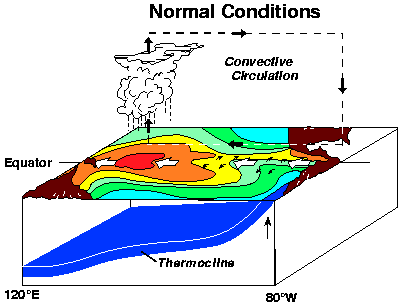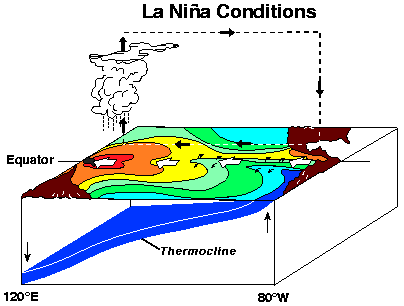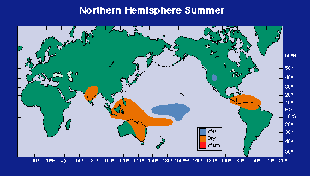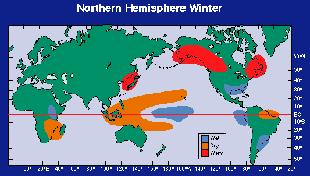|
|
return to
|
||||||||
Creating an Earth System:
El Niño |
|||||||||
|
|
|||||||||
|
|||||||||
Southern OscillationThe Southern Oscillation (S0) is an irregular "see-saw" in which atmospheric pressure and wind patterns shift across the Pacific. When normally high pressure in the eastern Pacific decreases and normally low pressure over Australia and northern Indonesia rises, conditions are right for an El Niño event to develop. As warm water shifts eastward, so do the convection and heavy rains caused by the increased buoyancy of air warmed by the underlying water. As warm water piles up in the east, upwelling of cold, nutrient-rich water is inhibited. Latent heat of condensation further warms the air, which further decreases atmospheric pressure in the east, etc. The thunderstorms that have shifted from the western to the central and eastern Pacific disrupt high-level jet stream circulation by pumping warm air and moisture high into the atmosphere. This has a far-reaching effect on weather patterns. |
|||||||||
Hazard/ImpactAlthough El Niño (and La Niña) are generated in the tropical Pacific, their effects are felt all over the world. The process by which Earth system events in one location are related to events in a different part of the world is called teleconnections.
General impacts:
Impact on California El Niño's storm track affects the location of jet streams, which are a major factor in producing winter weather patterns at mid-latitudes. Instead of coming ashore in the Pacific Northwest as usual, the southern jet stream hits California, carrying moisture and storms. In general, the effect of El Niño on California is increased rainfall with accompanying floods, landslides, and coastal erosion. The effects are variable across the state and are more predictable in Southern California. Effects of El Niño on the Biosphere
All images courtesy of USGS and ENSO (http://www.pmel.noaa.gov) |
|||||||||
|
Return to: Creating an Earth System I | Dynamic Earth Homepage | UCMP Homepege |
|||||||||
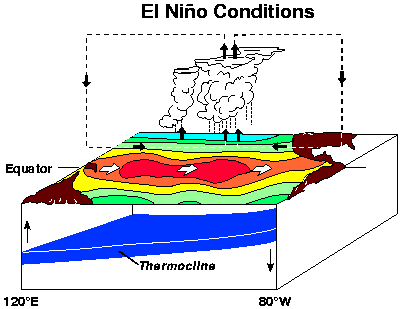 El
Niño is the result of an on-going "dialog" between the ocean and
atmosphere in the tropical Pacific Ocean. It's part of a natural,
combined oceanic-atmospheric cycle referred to as El Nino-Southern
Oscillation (ENSO)
El
Niño is the result of an on-going "dialog" between the ocean and
atmosphere in the tropical Pacific Ocean. It's part of a natural,
combined oceanic-atmospheric cycle referred to as El Nino-Southern
Oscillation (ENSO)